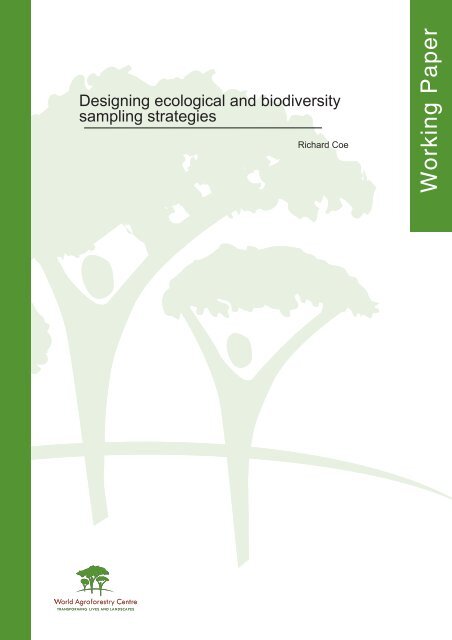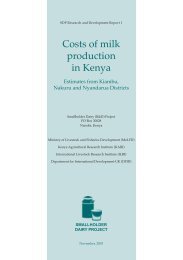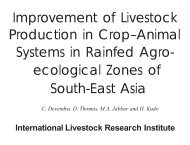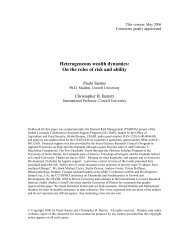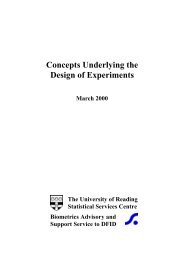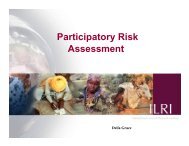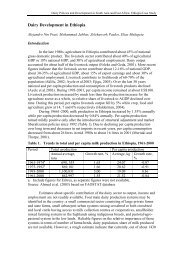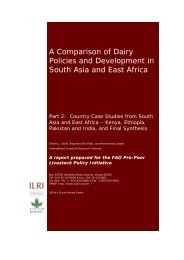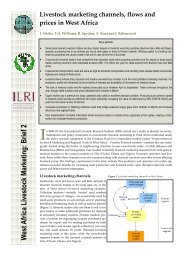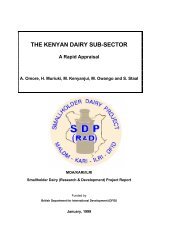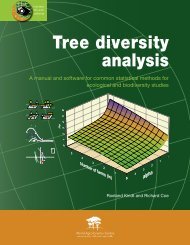Designing ecological and biodiversity sampling strategies
Designing ecological and biodiversity sampling strategies
Designing ecological and biodiversity sampling strategies
You also want an ePaper? Increase the reach of your titles
YUMPU automatically turns print PDFs into web optimized ePapers that Google loves.
<strong>Designing</strong> <strong>ecological</strong> <strong>and</strong> <strong>biodiversity</strong><strong>sampling</strong> <strong>strategies</strong>Richard Coe
<strong>Designing</strong> <strong>ecological</strong> <strong>and</strong><strong>biodiversity</strong> <strong>sampling</strong> <strong>strategies</strong>Richard Coe
LIMITED CIRCULATIONCorrect citation: Coe, R. 2008. <strong>Designing</strong> <strong>ecological</strong> <strong>and</strong> <strong>biodiversity</strong> <strong>sampling</strong> <strong>strategies</strong>.Working Paper no. 66Titles in the Working Paper Series aim to disseminate interim results on agroforestry research <strong>and</strong>practices <strong>and</strong> stimulate feedback from the scientific community. Other publication series from theWorld Agroforestry Centre include: Agroforestry Perspectives, Technical Manuals <strong>and</strong> OccasionalPapers.Published by the World Agroforestry CentreUnited Nations AvenuePO Box 30677, GPO 00100Nairobi, KenyaTel: +254(0)20 7224000, via USA +1 650 833 6645Fax: +254(0)20 7224001, via USA +1 650 833 6646Email: icraf@cgiar.orgInternet: www.worldagroforestry.org© World Agroforestry Centre 2008Working Paper no. 66This paper forms part of Chapter 2 of A H<strong>and</strong>book Of Tropical Soil Biology: Sampling <strong>and</strong>Characterization of Below-ground Biodiversity, edited by Fatima M. Moreira, E. Jeroen Huising <strong>and</strong>David E. Bignell (2008, Earthscan, London, ISBN 978-1-84407-593-5). This paper is publishedseparately with permission of Earthscan.The views expressed in this publication are those of the author <strong>and</strong> not necessarily those of theWorld Agroforestry Centre.This publication may be quoted or reproduced without charge, provided the sourceis acknowledged.ii
About the authorsRichard Coe,Head of the ICRAF-ILRI Research Methods Group,World Agroforestry Centre (ICRAF),PO Box 30677, Nairobi, Kenya.r.coe@cgiar.orgiii
AbstractEmpirical studies of patterns in <strong>biodiversity</strong> <strong>and</strong> other <strong>ecological</strong> phenomena requirefield measurements. While finding a method of measurement at a predetermined sitecan be challenging, the locations at which samples are to be taken also have to bechosen. Despite many years of empirical field research in ecology, many studies seemto adopt designs which are poorly suited to their purpose. This paper discusses someof the key issues regarding <strong>sampling</strong> design in such studies.Objectives of the study should drive all aspects of design, hence clear <strong>and</strong>unambiguous objectives are a prerequisite to good design. These objectives mustinclude testing hypotheses. Most practical designs are hierarchical. Questions ofreplication <strong>and</strong> sample size can only be addressed once the hierarchy is understood,<strong>and</strong> the scales at which different objectives will be met are identified. Stratification isa key tool in making the design efficient for testing hypotheses. At any level in thehierarchy there are options of using either systematic or r<strong>and</strong>om <strong>sampling</strong>, withadvantages <strong>and</strong> disadvantages of both. High levels of unexplained variation aretypical in many <strong>ecological</strong> studies, <strong>and</strong> may mean no useful results are obtained. Thepaper discusses <strong>strategies</strong> for coping with high variation.iv
AcknowledgementsThe ideas in this paper were prompted by discussions with Jeroen Huising <strong>and</strong> othermembers of the CSM-BGBD project team. I also acknowledge UNEP-GEF, whichprovided funds enable us attend project meetings, Simoneta Negrete Yankelevich forvery helpful comments on the initial draft, <strong>and</strong> Earthscan for granting me permissionto publish separately this version of a book chapter.v
Contents1. Introduction................................................................................................................12. Study objectives <strong>and</strong> <strong>sampling</strong> basics........................................................................33. Practical approaches...................................................................................................6Step 1: Define objectives ..........................................................................................7Step 2: Review other studies......................................................................................7Step 3: Assemble background data............................................................................7Step 4: Produce a design............................................................................................7Step 5: Review the design..........................................................................................8Step 6: Pilot.................................................................................................................8Step 7: Iterate .............................................................................................................84. Hierarchy, replication <strong>and</strong> sample size ......................................................................85. Focus on objectives: stratification ...........................................................................136. R<strong>and</strong>om <strong>and</strong> systematic <strong>sampling</strong>............................................................................147. Dealing with variability ...........................................................................................178. Other considerations ................................................................................................19References....................................................................................................................21vi
1. IntroductionThe study <strong>and</strong> underst<strong>and</strong>ing of <strong>biodiversity</strong> has become increasingly important overthe past few years, with much data being collected, interpreted <strong>and</strong> discussed. Yet,there is no single operational definition of the term ‘<strong>biodiversity</strong>’ (Magurran 1996,Yankelevich 2008). This is not uncommon in ecology <strong>and</strong> other areas of research.Often vague <strong>and</strong> complex concepts (such as sustainability or poverty) are discussedwithout definition. Scientists take implicit definitions, selecting practical indicatorswhich, they argue, describe the aspects of the phenomenon that they interested in.This weak link in scientific method is at the heart of much debate. In this paper, I donot attempt to resolve the issue. Instead, I assume that the definition <strong>and</strong> indicatorstaken in any study have some validity <strong>and</strong> focus on problems of designing datacollection for any defined indicator.Empirical studies of patterns in <strong>biodiversity</strong> <strong>and</strong> other <strong>ecological</strong> phenomena requirefield measurements. This paper discusses some of the key issues regarding the choiceof measurement methods <strong>and</strong> selection of sites for <strong>sampling</strong>. It was motivated by alarge study of below ground <strong>biodiversity</strong> (Conservation <strong>and</strong> Sustainable Managementof Below Ground Biodiversity (CSM-BGBD), http://www.bgbd.net/), but the ideasare useful in other application areas.As will be discussed in Section 3, the problem of choosing the location ofmeasurement points is one that occurs at different scales. At one scale, we have tochoose where the whole study will be located. At another, we need to choose where ata measurement site (e.g. a 20 x 20 m quadrant) 4 cores for soil chemical analysis willbe taken. Somewhere between the two is the problem of choosing the measurementsites. While the argument gets a little more complex than this, the problem can bevisualised as choosing the number <strong>and</strong> location of points in the study l<strong>and</strong>scape atwhich the measurement protocols will be implemented.There is a long tradition of <strong>sampling</strong> in field ecology, <strong>and</strong> hence much experience hasbeen gathered in this field. In addition, there is a well established theory of <strong>sampling</strong>for any application area (Cochran, 1977). There are numerous texts describing boththeory <strong>and</strong> application (e.g. Southwood <strong>and</strong> Henderson, 2000; Gregoire <strong>and</strong>Valentine, 2007). So why is another discussion of <strong>sampling</strong> in ecology needed?Despite the knowledge <strong>and</strong> experience, in any project there will be intense — <strong>and</strong>sometimes divisive — discussion of the <strong>sampling</strong> strategy. There are a number ofreasons for this:1
2. Study objectives <strong>and</strong> <strong>sampling</strong> basicsMost authors on research study design emphasise the point that the design isdetermined by the objectives. Kenkel et al (1989) explain this clearly in the context of<strong>ecological</strong> <strong>sampling</strong>. Many of the debates about appropriate <strong>sampling</strong> methods turnout to be due to differences of opinion as to the exact objectives of the study. Ford(2000) comprehensively discussed research objectives <strong>and</strong> approaches in ecology.Simple r<strong>and</strong>om <strong>sampling</strong> (SRS) is the starting point for discussions on <strong>sampling</strong>. Ifthe objective is to estimate a population mean (such as the mean biomass of beetlesper m 2 within the study area, or the mean number of fungi species within 1 cm 3 ), thenSRS has important properties. The mean of the sample is an unbiased estimate of thepopulation mean, <strong>and</strong> its st<strong>and</strong>ard error can be estimated without making anyassumptions about the variation within the population (technically, a design-basedestimate of <strong>sampling</strong> error is available). It is also intuitively appealing. St<strong>and</strong>ardtheory then shows how the precision of the estimate can be controlled by choice ofsample size <strong>and</strong> the precision increased (for a fixed sample size) by stratification. Auseful alternative to SRS is systematic <strong>sampling</strong> on a grid, discussed in Section 6.But few <strong>ecological</strong> surveys have the limited objective of estimating such a populationmean. An example of an objective that requires a very different approach to <strong>sampling</strong>is that of inventory. If the aim is to identify all the species of a given group occurringin the study area, then SRS is not appropriate. Think of a rare niche in the l<strong>and</strong>scape(e.g. the bank of a pond which falls on the boundary between forest <strong>and</strong> field). Therewill be a tiny proportion of the whole study area occupied by such niches, so if we aretrying to estimate the mean beetle biomass, it does not matter if such locations areomitted from the sample. But those rare niches may well be home to species foundnowhere else in the area <strong>and</strong>, hence, should be included when the objective isinventory.Many studies of <strong>biodiversity</strong> aim to underst<strong>and</strong> patterns of species occurrence. Oneapproach to <strong>sampling</strong> is to collect data by SRS or a grid sample, describe the patterns(for example by clustering <strong>and</strong> ordination) <strong>and</strong> then to explain them (for example,finding correlations with environmental variables). The alternative is to formulatesome hypotheses predicting <strong>and</strong> explaining patterns in <strong>biodiversity</strong>, then design astudy specifically aiming at testing the hypotheses.Proponents of the first approach may claim that they do not want to be ‘biased’ byinitial hypotheses or have their imagination <strong>and</strong> potential discoveries constrained by3
starting out with a limited objective. They would rather ‘keep an open mind’ <strong>and</strong> seewhat they can see. Of course important discoveries in ecology have been made bychance rather than through planned studies, <strong>and</strong> every scientist should permanently beopen to the possibility of unanticipated observations, <strong>and</strong> truly novel explanations.But there are at least four reasons for trying to design a study with specific objectives,including testable hypotheses.1. Without a clear hypothesis, it is impossible to say whether finding no pattern is theresult of none existing or of inadequate (insufficient or inefficient) <strong>sampling</strong>. There isno basis for evaluating the success of such a study.2. Those serendipitous discoveries that might be made usually have the nature ofhypothesis formulation — observations which suggest explanations. Carefullyplanned studies are needed to test the explanations.3. The proponents of the ‘no hypothesis’ approach actually do have some hypotheses,but these are implicit. For example, without some notion of environmental factors thatmight be controlling <strong>biodiversity</strong>, it is impossible to choose which of an almostinfinite number of such factors should be measured at sample locations. If the implicithypotheses are made explicit, study designs can be improved.4. If we have specific hypotheses, it is often possible to improve the study design,making the study more efficient.The last point is behind much of what follows in this paper. Suppose the hypothesis isthat an indicator of below ground <strong>biodiversity</strong> (BGBD) in agricultural plots isdetermined by the level of disturbance (D) <strong>and</strong> the level of soil organic matter (SOM).If we collect data by SRS or grid <strong>sampling</strong>, then it is likely that:a) Most sample locations will have values of D <strong>and</strong> SOM around the average,with relatively few points with very high or low values. But when seekingto underst<strong>and</strong> the relationship between BGBD <strong>and</strong> SOM or D, it is themore extreme points that provide most of the information (Figure 1).Stratification — dividing the population or study area into sub-populations<strong>and</strong> deliberately <strong>sampling</strong> each — can be used to increase the number ofpoints with more extreme SOM <strong>and</strong> improve the estimate of therelationship without increasing the number of samples.4
) SOM <strong>and</strong> D may well be correlated, for example with plots with high Dtypically having low SOM. In such a case, it is hard or impossible todisentangle the effects of the two variables. However, the study could bedesigned to deliberately include some samples with high D <strong>and</strong> high SOMas well as others with low D <strong>and</strong> low SOM. Then the effects of bothvariables, <strong>and</strong> their combined effect, can be estimated.In practice, it may not be possible or useful to produce a single index of BGBD or D,as plotted in Figure 1, <strong>and</strong> relationships may be more complex than straight lines butthe same principles of design apply.a. b.BGBDBGBDSOMSOMFigure 1. Designs for estimating the relationship between BGBD <strong>and</strong> SOM.(a) Simple r<strong>and</strong>om or grid <strong>sampling</strong> will probably give most SOM values near theaverage, <strong>and</strong> a poor estimate of the line. (b) Deliberately including samples moreextreme SOM values through stratification increases the precision of the estimate ofthe line at no extra cost.Another example of a hypothesis implicit in many studies is that of the spatial scale atwhich interesting patterns occur. By choosing the distance between sample locations<strong>and</strong> the overall size of the study area, the scientist is making choices <strong>and</strong> assumptionsabout the important scales to study. If these are made explicitly, then they are open todebate, with a likely improvement in the study design.The overall objective of a project may be to test the hypothesis that increasing l<strong>and</strong>use intensity changes an indicator of below ground <strong>biodiversity</strong>, as in the CSM-BGBD project. This is a rather general statement, but can still be helpful in focusingdesign of <strong>sampling</strong>. Ideally we would investigate it with an experiment. The only5
certain way to determine the effect of changing something is to change it, <strong>and</strong> that isthe basis of an experimental approach. However, this is often not feasible. If we haveto use an observational study design, rather than experimental, then the ideal would bea longitudinal study, in which plots are monitored over time to see whether changes inBGBD are correlated with changes in l<strong>and</strong> use.Generally, this is also not feasible in a project of a short <strong>and</strong> fixed duration, as thetime over which monitoring may be needed is unknown. Hence the study, like manyothers, will have to use a cross-sectional approach, looking at a range of l<strong>and</strong> uses atone time point. The hope is that correlations between l<strong>and</strong> use intensity <strong>and</strong> currentBGBD do reflect some causal connections <strong>and</strong> give indications of what would happento BGBD if l<strong>and</strong> use changes take place in the future. Though the validity of thisapproach can be questioned, it is often the only option available. Discussions in thispaper therefore only consider alternative <strong>sampling</strong> schemes for collecting crosssectionaldata.Note that if historical l<strong>and</strong> use data is available, then it is potentially possible toexamine the effect of different histories of l<strong>and</strong> use. For example, comparing l<strong>and</strong> useA following B with A following C. However, if A always follows B, it is not possibleto determine whether differences between A <strong>and</strong> D are a property of A, of B, or of thesequence B followed by A.3. Practical approaches<strong>Designing</strong> a successful, practical <strong>sampling</strong> scheme is an art 1 . It requires deepunderst<strong>and</strong>ing of the scientific basis of the research <strong>and</strong> of the properties of alternativemethods. But these need to be blended with the practical constraints imposed by cost,the time <strong>and</strong> expertise available. There may well be additional constraints such aslimited access to desirable sample locations, or the need to rapidly transport samplesfrom the field to the lab. Details of how these practical <strong>and</strong> theoretical sides can bemerged will be different for every study <strong>and</strong> give each investigation its own uniqueaspects. However, it is possible to outline steps in the process that can be followed inany study.1 There may be some discomfort in using ‘art’ in this context, as it implies subjective judgement. There should be no subjectivityin deciding whether a design is capable of testing a well-specified hypothesis. But there is subjectivity in the assessment of adesign as practical, manageable in the field, acceptable to technicians <strong>and</strong> farmers, <strong>and</strong> so on.6
Step 1: Define objectivesAs outlined in Section 2, the objectives determine all aspects of the design. Hencethey must be clearly <strong>and</strong> precisely determined at the start. Objectives of a researchstudy must include testing of precisely stated hypotheses. A study may well haveadditional objectives, such as compiling a species inventory or estimating parametersthat characterise the study area, that are not usefully stated as hypotheses.Write down the objectives, so that it is easy to share them with others for suggestionson how to improve them. Get comments <strong>and</strong> suggestions from as many otherscientists as you can. These could be scientists working on similar topics but in otherlocations, those who have worked in the same location or those with experience in themethods you plan to use.One tool to help refine objectives is the simulated presentation of results. Imagine youhave completed the study <strong>and</strong> obtained results. What tables <strong>and</strong> graphs would you liketo be able to present to meet your objectives <strong>and</strong> provide evidence for yourhypotheses? Write these down, with realistic numbers <strong>and</strong> patterns.— Figure 1 is asimple example. Then check carefully (a) that those results really would meet theobjectives <strong>and</strong>, in particular, allow you to reach conclusions about the hypotheses, <strong>and</strong>(b) that the sample design imagined could give those results.Step 2: Review other studiesLook at reports from other related studies. While each study has some unique aspects,you can learn from earlier studies. Try to underst<strong>and</strong> which aspects of the methodsused appeared successful, <strong>and</strong> which ones seemed to limit the efficiency or quality ofresults. Note in particular sample sizes used <strong>and</strong> the variability in results.Step 3: Assemble background dataAssemble background information that will be needed to design <strong>sampling</strong> details.These include topological maps (for example, to stratify by altitude or underst<strong>and</strong>access problems), remote sensing images (to map ground cover), l<strong>and</strong> use maps (toidentify the main l<strong>and</strong> uses to include in the study), meteorological data (to helpdecide on suitable seasons for field <strong>sampling</strong>).Step 4: Produce a designProduce a tentative design using a combination of general principles, your ownexperience, designs used in other studies <strong>and</strong> imagination. There may be aspects you7
do not know much about, but make a realistic suggestion. Write the design down in asmuch detail as possible.Step 5: Review the designGive the design to other scientists to review <strong>and</strong> make comments. Again, these maybe people who have worked on similar topics, used similar methods, worked in thelocation or are generally perceptive. Include a statistician with experience in<strong>ecological</strong> research. A statistician is likely to see aspects of the problem thatecologists might be missed.Step 6: PilotTry out the approach. A pilot investigation is a chance to evaluate the practicality ofthe <strong>sampling</strong> scheme. It also allows testing <strong>and</strong> refinement of measurement protocols,data h<strong>and</strong>ling procedures, etc. It also allows estimation of the time needed to find,collect <strong>and</strong> process samples. If it is possible to process some measurements to thepoint of statistical analysis, the pilot also gives an indication of variability, which canthen be used to decide final sample sizes.Step 7: IterateAt any step, expect to go back to an earlier one <strong>and</strong> try again. In particular, reviseobjectives in the light of new information <strong>and</strong> insights. A common mistake is to getinformation which suggests the objectives are unobtainable but to carry on anyway.4. Hierarchy, replication <strong>and</strong> sample sizeMost study designs are hierarchical <strong>and</strong> the <strong>sampling</strong> problem is not simply one ofselecting measurement locations within a study area. The CSM-BGBD projectprovides a good example. It involves several countries. Within each country one ormore benchmark locations were selected. In each benchmark, one or more study areas(labelled ‘windows’) were selected. Within each study area, about 100 samplelocations were selected. Measurements are taken at each sample location Themeasurement protocol defines further layers in the hierarchy, such as 4 cores beingtaken for soil characterisation, <strong>and</strong> subsamples of the cores subject to chemicalanalysis.At each layer in the hierarchy, the basic <strong>sampling</strong> questions recur: How many unitsshould be selected <strong>and</strong> which ones? At the highest levels, the answers may not be8
ased on scientific grounds. Selection of countries may be based on politics or theinterests of funders <strong>and</strong> researchers leading the project. But at some level, selectionshould be based on the objectives of the study <strong>and</strong> application of some principles.The first is the <strong>sampling</strong> theory idea of a ‘population’ to be sampled. The terminologyis confusing, as this has nothing to do with a biological population. The notion is oneof knowing what your results will refer to. As an example, we could study belowground <strong>biodiversity</strong> on farms around the forest boundary of Mt Kenya. That wouldrequire a sample of farms from that location. If we wanted results that apply to theforest boundaries on mountains in East Africa generally, then we need samples fromsome of the other mountains as well. Without that, we can only make statementsabout Mt Kenya on the basis of the data, with extrapolation to other locationsdependant on other information or assumptions. The implication for <strong>sampling</strong> is thatthe overall area about which we want to makes inferences (the ‘population’) needs tobe delineated before a <strong>sampling</strong> scheme can be determined.The second idea is that of replication, which concerns consistency of patterns <strong>and</strong>relationships. The aim of research is to find some patterns, such as patterns of belowground diversity related to l<strong>and</strong> use. Patterns of interest are those which are consistentacross a number of cases, as it is only these that can be used for prediction <strong>and</strong> mayreflect some underlying rules or processes. Hence we need repeated observations todetermine whether patterns are indeed consistent.Suppose we have 10 samples taken from a forest <strong>and</strong> 10 from nearby cultivated fields,<strong>and</strong> the forest plots consistently have higher BGBD. What can we conclude? If thesamples were selected appropriately, we can conclude (to a known degree ofuncertainty assessed by the statistical analysis) that the forest is more diverse than thefields. But strictly speaking, we can only conclude that that particular forest is morediverse, not forests in general. If we seek a more general conclusion, then we shouldlook for consistency across several forests.Within a hierarchical study design, higher level units such as benchmark sites mayprovide one level of replication <strong>and</strong> consistent patterns across benchmark sitesprobably represent some widely applicable ‘rule’. But within benchmark, sites wewould make stronger conclusions if we ensured that several, rather than a single,forest (or other l<strong>and</strong> use element), are sampled. Multiple samples from the same forestmay not serve the same purpose, representing ‘pseudo-replicates’. The extent towhich repeated samples within one forest serve the same purpose, or can beinterpreted the same way as samples from different forests depends on properties ofthe data <strong>and</strong> not of the design. The safe approach is to ensure valid replication <strong>and</strong>some generic results by a design that replicates forests <strong>and</strong> other l<strong>and</strong> use elements.9
a. b. c. d.Figure 2: Four approaches to using grid <strong>sampling</strong> in a l<strong>and</strong>scape with two l<strong>and</strong> uses,forest <strong>and</strong> agriculture. (a) A single grid that includes 1 forest patch, (b) 3 grids thatsample 3 different forest patches, (c) increasing the replication, <strong>and</strong> (d) recognisingthe boundaries as another category.Some of the implications of these ideas for grid <strong>sampling</strong> (Section 6) are illustratedfor a simplified example in Figure 2. The aim is to sample a l<strong>and</strong>scape with two l<strong>and</strong>uses, labelled ‘forest’ <strong>and</strong> ‘agriculture’, in order to examine differences in BGBD. InFigure 2a, a single large grid has been laid down in such a way as to include both l<strong>and</strong>uses. The grid is a single ‘window’ with 77 <strong>sampling</strong> locations (intersections) defined.In Figure 2b, three smaller windows are used in order to sample three different forestpatches, rather than one only. The replication can be further increased, <strong>and</strong> more ofthe whole study area observed, by using more, smaller windows (Figure 2c).One criticism of this third design is that all the sample locations in agricultural l<strong>and</strong>fall close to a forest boundary, <strong>and</strong> may not be considered representative of the l<strong>and</strong>use. A response to this is to define a new category of ‘forest boundary’ <strong>and</strong> ensurethat windows sample all three (Figure 2d). Notice that it is not necessary to have alll<strong>and</strong> uses sampled in each window. If this process of reducing the size of windowswhile increasing their number is continued, then eventually we loose the possibleadvantages of grid <strong>sampling</strong> (Section 6) <strong>and</strong> end up with a design that looks like ar<strong>and</strong>om sample of individual locations.‘Scale’ is a confusing <strong>and</strong> controversial idea in ecology (Peterson <strong>and</strong> Parker 1998),but it is clear that the scale at which we anticipate (or hypothesise) patternsdetermines the level in the hierarchy at which replication is required. For example, thehypothesis may be ‘BGBD in agricultural plots decreases with increasing distancefrom the forest edge’. This can be investigated with plots (sample locations) at a rangeof distances, with replication of each distance.10
A different hypothesis is ‘BGBD in agricultural plots decreases with decreasing forestcover in the l<strong>and</strong>scape’. Here we need to define what is meant by ‘in the l<strong>and</strong>scape’— that is, the spatial scale at which forest cover is assessed. Suppose that was definedas areas of 1km 2 . Then the hypothesis needs a sample of 1km 2 units with varyinglevels of forest cover. Replication now dictates the need for several such units at eachlevel of forest cover. To assess the BGBD within such a 1km 2 unit, will requirefurther <strong>sampling</strong>, with definition of some sample locations within each unit. Thereplication at the within-unit level is important for determining the precision withwhich the BGBD for each unit is measured, but it is not relevant to affirming theconsistency of pattern across 1km 2 units, needed to examine the hypothesis.In other areas of ecology, l<strong>and</strong>scape factors (e.g. forest fragmentation) are found toaffect processes, so objectives of a BGBD project may include ‘l<strong>and</strong>scape analyses’.The two examples in the previous paragraph are both examples of analyses that usel<strong>and</strong>scape factors, yet are based on data from different levels in the hierarchy — oneusing plot-level data <strong>and</strong> the other data from 1km 2 units. The message is clear:‘l<strong>and</strong>scape level’ is not well defined <strong>and</strong> aiming to do a ‘l<strong>and</strong>scape level analysis’does not tell you the <strong>sampling</strong> design needed.Once we know what is to be replicated, st<strong>and</strong>ard methods are available to help selectsample size <strong>and</strong> so is software to implement them. The methods require knowledge oftwo things: the magnitude of difference (for example, differences in BGBD betweentwo l<strong>and</strong> uses) that it is important to detect, <strong>and</strong> the variability between replicates ofthe same l<strong>and</strong> use. It is clear why the sample size decision depends on these, but it isusually rather hard to specify them. When research is directed at measuring economicresponses to management decisions (e.g. crop response to fertilizer), then it is feasibleto specify a minimum response that it is important to detect. However, when theresearch aims to detect <strong>and</strong> underst<strong>and</strong> processes, it is often impossible to specify asize that is important.A rough estimate of variance between replicates can often be obtained from previousstudies, but how relevant these will be in new environments may be unknown.Another complication arises from the multivariate responses of interest. The st<strong>and</strong>ardmethods assume there is a measured response of BGBD that we can use whenplanning sample size. But any real study has multiple responses of interest, such asthe diversity of different functional groups measured in different ways, numbers,biomass <strong>and</strong> ratios of these for functional groups or even species, <strong>and</strong> so on. Hence, inpractice, sample size has to be based on a combination of information from formalmethods — which can give indications of orders of magnitude needed — previoussimilar studies <strong>and</strong> pilots.11
A <strong>sampling</strong> design <strong>and</strong> sample size determined in this way will not be that which,given perfect information, would be optimal. But if serious consideration is given tosample size, then the study has a greater chance of succeeding <strong>and</strong> providinginsightful results than if the sample size were simply that which you first thought of orthe maximum that you can afford.Several ‘newer’ <strong>sampling</strong> approaches have been developed. Sequential designs(Pedigo <strong>and</strong> Buntin 1993) allow <strong>sampling</strong> to continue until some criteria are met.While theoretically attractive, they are unlikely to be practical for many studies aswork needs planning in distinct phases of field <strong>and</strong> lab, with many measurements onlybecoming available a long time after field <strong>sampling</strong>. Adaptive <strong>sampling</strong> (Thompson<strong>and</strong> Seber 1996) allows the design to respond to patterns being detected. Again, thereare some attractions in the idea but they are unlikely to be feasible given the need toplan field campaigns in advance. A range of multiscale designs have been used in<strong>ecological</strong> studies. The idea of these designs is to choose <strong>sampling</strong> positions so thatpatterns at several different scales can be investigated. Fine scale patterns requirepoints close together. Larger scale patterns require points further apart. Hence, bothare included, with efficient designs having a clustered structure (Stein <strong>and</strong> Ettema2003; Urban et al, 2002).At each selected <strong>sampling</strong> location, further <strong>sampling</strong> is usually required in order totake measurements (Section 8). Think of the selected location not as a point but asplot, perhaps with an area of the order of 100 m 2 . If measuring BGBD, <strong>sampling</strong> isneeded within this plot, as only a very limited volume of soil can actually beexamined for most BGBD measurements, <strong>and</strong> several samples are taken to representthe whole plot. However, typically, the measurements within each plot are bulked —that is, the several soil samples from the plot are mixed before measurement of theBGBD. There are two reasons for bulking. One is simply practical. There would betoo many samples to process without bulking. The second is the need for coincidentmeasurements of different functional groups of BGBD. If several groups of speciesare being assessed, then presumably the relationships between them are important.This means they must be measured in the same place. However, it is usually onlypossible to examine one group in a given soil sample, <strong>and</strong> extracting the sample forone group may disturb it for others. Hence all measurements are at the plot level.This means that variation <strong>and</strong> patterns at the scale of within-plot (e.g.
5. Focus on objectives: stratificationIn the introduction to this paper, I suggested that focussing on objectives of a studywill increase the efficiency of the design. Consider the example of the objective ofdiscovering <strong>and</strong> underst<strong>and</strong>ing l<strong>and</strong> use effects on BGBD. This requires comparisonof different l<strong>and</strong> uses. One approach to improving the <strong>sampling</strong> design (relative toSRS or a single grid) is to use ‘stratification’ to ensure that we do indeed haveadequate sample sizes of each l<strong>and</strong> use. Used in this sense, the strata are l<strong>and</strong> areasunder different uses, <strong>and</strong> the idea is to deliberately sample from each of these. It issometimes suggested that this approach is ‘biased’, as the l<strong>and</strong> use classes to sampleare determined a priori. If the data were used to make statements about the overallstudy area (e.g. the mean number of beetles per m 2 ) without accounting for the design,then the result may be biased, as different l<strong>and</strong> uses may not be represented in thesample with frequencies that are proportional to their occurrence in the study area.But the design is not biased for the objective of comparing l<strong>and</strong> uses. Furthermore, itis efficient. If we have a total of N samples to compare two l<strong>and</strong> uses, then, in theabsence of further information, the best design is to have N/2 in each of the twogroups. With the stratified <strong>sampling</strong> approach we can choose a suitable sample sizefor each l<strong>and</strong> use.If this approach is to be employed, then there are two prerequisites:1. We need to know which l<strong>and</strong> uses will be compared <strong>and</strong> have precise definitions ofthem.2. The location of these l<strong>and</strong> uses must be known — a l<strong>and</strong> use map of the study area isneeded.The first of these makes some scientists uncomfortable, with the feeling that priordefinition of the l<strong>and</strong> uses to investigate excludes discovery of potentially importantpatterns. But the definition has to be done at some stage anyway. The need to definethem precisely also has to be done at some time. For example, where is the boundarybetween ‘pasture with trees’ <strong>and</strong> ‘secondary forest’ along a gradient of increasing treecover? Here, we have another potential gain in efficiency from thinking through theserequirements at design rather than only analysis stage. If a <strong>sampling</strong> design does nottake l<strong>and</strong>use into account, then there is a good chance that many of the selectedsample locations will end up in positions of ambiguous l<strong>and</strong> use definition that we are13
not sure how to classify. With the stratified approach, these areas can be excludedfrom the <strong>sampling</strong>. Of course, if the aim is inventory of the l<strong>and</strong>scape, we do not wantto exclude some l<strong>and</strong> use types <strong>and</strong> transition zones may be important. But if the aimis to investigate l<strong>and</strong> use effects, it does make sense to exclude such locations.If the objectives include investigation of boundaries between areas of different l<strong>and</strong>use, or of rare niches such as linear features, then these should be specificallyincluded in the <strong>sampling</strong>. If this is not done, the sample is likely to include only a fewobservations of these categories from which nothing can be concluded. It is muchmore efficient to either (1) include them with a large enough sample size if they arerequired by the objectives, or (2) exclude them (give them a sample size of zero) ifthey are not required by the objectives.Note that similar arguments apply if the hypothesised factors influencing BGBD arenot forms of l<strong>and</strong> use per se, but environmental variables influenced by l<strong>and</strong> use, suchas SOM or frequency of fire.The requirement to have l<strong>and</strong> use mapped for use in <strong>sampling</strong> should not be aconstraint. Interpretation of remote sensed imagery is a possibility, although not easyif other l<strong>and</strong> use maps of suitable resolution are not available. The same may not betrue if variables such as SOM are to be used for stratification. It may be useful to do arapid survey of SOM, calibrate it to a l<strong>and</strong>-use map or RS image <strong>and</strong> use that to definestrata.6. R<strong>and</strong>om <strong>and</strong> systematic <strong>sampling</strong>The essential reasons for using simple r<strong>and</strong>om <strong>sampling</strong> (SRS) in many applicationswere outlined in Section 2 <strong>and</strong> are elaborated in texts such as Cochran (1977). Toimplement SRS, it is necessary to delineate the study area <strong>and</strong> then select <strong>sampling</strong>locations inside it at r<strong>and</strong>om. This should be done in such a way that (a) every point isequally likely to be selected, <strong>and</strong> (b) selection of one point does not change theprobability of including any other point. Stratified r<strong>and</strong>om <strong>sampling</strong> requires doingthe same thing within each stratum. With software to aid in the r<strong>and</strong>omisation <strong>and</strong>GPS to locate selected sample locations in the field, this scheme is feasible. However,<strong>ecological</strong> <strong>sampling</strong> often uses non-r<strong>and</strong>om sample selection, sometimes for goodreasons.A common non-r<strong>and</strong>om approach is subjective selection of sample locations. Thismeans, for example, choosing the samples to include sites judged to be interesting orimportant, <strong>and</strong> is often the basis for selecting <strong>sampling</strong> units at higher levels in the14
hierarchy. While sometimes necessary, this approach is limited because the‘representivity’ of the sampled area (the extent to which findings can reasonably beassumed to apply to a larger population) depends on the judgement of the designer,not on any inherent property of the design. It is therefore open to dispute when resultsare presented. If a subjective sample of size 1 is taken, this is equivalent to limitingthe study area. For example, if a single ‘window’ is subjectively placed in abenchmark area, then in fact we have reduced the study to that window, <strong>and</strong> any claimto represent the benchmark area depends solely on the expertise of the designer.Systematic <strong>sampling</strong> has found much application in ecology, both with 1-d transects<strong>and</strong> 2-d grids. In the case of transects, samples are selected at points in a fixeddistance apart along a predetermined line. For grid <strong>sampling</strong>, a (usually) rectangulargrid is defined in the area <strong>and</strong> samples taken at each intersection point. The potentialadvantages of these types of systematic <strong>sampling</strong> derive from both theory <strong>and</strong>practice. The practical advantages include:• Ease of locating <strong>sampling</strong> points <strong>and</strong> description of the location <strong>and</strong> means of findingthem in the field. For example, the protocol may be something as simple as, ‘from thestarting point, walk north <strong>and</strong> sample every 50m’.• Ease of planning field work, for example, estimating the time needed to sample a fixednumber of points.The statistical reason for using grid <strong>sampling</strong> is because they can be efficient(Webster <strong>and</strong> Oliver, 1990). Consider a study with the objective of measuring theaverage or total of some quantity (for example total soil carbon in the study area oraverage number of beetles per m 2 ). A grid sample will give a better estimate than asimple r<strong>and</strong>om sample of the same size if the measured quantity varies in a patchyway, which is typical for environmental <strong>and</strong> biological variables. The efficiencycomes from the fact that closely neighbouring points are similar to each other <strong>and</strong> sodo not add much new information. In addition, the grid spreads the sample as evenlyas possible through the study area. For similar reasons, the grid approach can beexpected to be good for compiling the inventory of a study area, except that it maymiss rare niches (see below).There are some negative aspects of grid <strong>sampling</strong>. These include:1. Some points of the grid may be at points which should not be included in the study,such as roads or water bodies. Obviously these must be excluded.15
2. Grids will sample different l<strong>and</strong> uses with a sample size roughly proportional to theareas of those different l<strong>and</strong> uses. In particular, rare l<strong>and</strong> use classes may be omittedcompletely. While this can be compensated by moving the window around <strong>and</strong>adding points, the process could be rather arbitrary <strong>and</strong> subjective.3. It is sometimes not possible to characterise the l<strong>and</strong> use unambiguously at everysample point.These are all related to the problem discussed in Section 5. If the aim of the study iscomparison of l<strong>and</strong> use classes, then grid <strong>sampling</strong> may not capture those in anoptimal way. Thus, grids <strong>and</strong> transects are probably most appropriate for <strong>sampling</strong>when either (a) there is no explicit objective or hypothesis involving comparison orrelationship with environment variables, or (b) the hypothesis refers to a higher levelspatial unit than the scale at which the grid or transect <strong>sampling</strong> is done. For example,Swift <strong>and</strong> Bignell (2001) recommend 40m long transects, but these are within eachl<strong>and</strong> use class.For the purpose of comparing l<strong>and</strong> uses, transects are replicated <strong>and</strong> r<strong>and</strong>omised tostrata defined by different l<strong>and</strong> uses. In this way, systematic grid or transect <strong>sampling</strong>are usually combined with r<strong>and</strong>om <strong>sampling</strong>. For example, there may be several gridsdefined, as in Figure 2d, with their location <strong>and</strong> orientation r<strong>and</strong>omised. Similarly, thestarting points <strong>and</strong> orientation of repeated transects may be r<strong>and</strong>omly oriented.Transects can also usefully be aligned with environmental gradients hypothesised tobe important when they are known as ‘gradsects’ (Wessels et al 1998). Withr<strong>and</strong>omisation at some level in the hierarchy, statistical analysis based on the r<strong>and</strong>omproperties of the design is possible. For example, if a number of small grids arer<strong>and</strong>omly placed in the study area, then we have the replication necessary to establishthe consistency across windows of patterns found.Statistical analysis at the sample point level of data collected by grid <strong>sampling</strong> cannotbe based on r<strong>and</strong>omisation, as the locations were not independently selected withineach grid. There are two possible approaches to analysis. One is to assume that thedata behave as r<strong>and</strong>om (i.e. the statistical properties are the same as if the point hadbeen r<strong>and</strong>omly located). The second is to use an explicit model of spatial pattern. Inmost analyses looking for relationships between environmental variables <strong>and</strong> BGBD,the former method is used, mainly because alternatives are complex. Theconsequences of this assumption are rarely investigated.It is clear that the spacing <strong>and</strong> overall size of a grid determine the scale of the spatialpatterns that it can be used to detect. It will not be possible to pick up patterns (e.g.patchiness in BGBD) at spatial scales less than the distance between points in the16
grid. Likewise, it will not be possible to detect patterns larger than the overall size ofthe grid. In fact, the maximum size must be less that the size of the grid, as thepatterns can only be recognised if there are several repeats within the grid. It is thisaspect of pattern scale, set by the objectives of the study, which should determine thespacing <strong>and</strong> overall size of a grid.It is sometimes suggested that grid spacing should be such that neighbouring pointsare uncorrelated. This notion of spatial correlation is important but also confusing.The correlation between measurements at a given distance apart is not an absolutequantity, but is measured relative to an average (technically, the issue is one ofstationarity). To see this, think of analysing data from a single window in Kenya.Points more than 200m apart may well show no similarity in BGBD. But if we putdata from a global dataset together, we would expect to find similarity not justbetween points in the same window but perhaps between all points in Kenya.7. Dealing with variabilityExperience from studies suggests that one should expect a high level of variation inmany key measurements in <strong>biodiversity</strong> or other <strong>ecological</strong> studies. Even over shortdistances we expect large variation in numbers <strong>and</strong> diversity of different functionalgroups. In tropical agricultural l<strong>and</strong>scapes, the variation within a l<strong>and</strong>-use categorymay be considerable in terms of management practices, variation in above-groundvegetation characteristics, differences in l<strong>and</strong> use history of the plot, edge effects,topographic position <strong>and</strong> bio-physical characteristics. If formal methods ofdetermining sample size requirements were followed through, they are likely to giveindications of sample size many times larger than that which is feasible <strong>and</strong>affordable. What should be done?First, there is no point in doing nothing. Simply carrying on with the preconceivedsample size will mean objectives will not be met. If the original plan was to haveabout 10 samples of each l<strong>and</strong> use within a benchmark site, <strong>and</strong> the indications arethat we need about 100 samples of each, there is no point continuing. The result willbe vague <strong>and</strong> inconclusive results, reflected in high st<strong>and</strong>ard errors <strong>and</strong> no significanteffects when analysing the data. There are three possible responses:1. Increase the sample size.2. Use <strong>sampling</strong> methods to reduce the variability3. Reduce the scope of the study.17
The first option is obviously impractical in many cases. There are always limitationsin time, money, facilities <strong>and</strong> expertise.There are various methods of reducing variability by <strong>sampling</strong>. Most useful arestratification <strong>and</strong> matching. Note this use of the term ‘stratification’ is the common asthat in <strong>sampling</strong>, but different from that in Section 5. If some sources of variabilitycan be predicted, they can be used to define strata <strong>and</strong> removed from the analysis. Forexample, if the benchmark site covers a range of altitudes, we may expect variation inBGBD by altitude. Stratification would then divide the site into altitude zones, <strong>and</strong>sample within each of these. During data analysis, l<strong>and</strong> uses would be comparedwithin strata <strong>and</strong> in-between stratum variation not obscure the results. This approachrequires that some (not all) different l<strong>and</strong> uses occur within given altitude zones. Ifl<strong>and</strong> use only varies with altitude,, then the two factors are confounded <strong>and</strong> theireffects on BGBD cannot be distinguished. It is typical for environmental variation tobe patchy, which explains some of the variation in response to show patchiness.Hence, strata may be usefully defined as geographically close sets of <strong>sampling</strong> points.The windows in Figure 2 can be seen in this way.Matching takes stratification to an extreme. Suppose two of the l<strong>and</strong> uses to becompared are forest <strong>and</strong> maize fields. We can expect the BGBD to depend on manyenvironmental variables such as climate, topography, soil <strong>and</strong> geology. Theseenvironmental variables typically vary in a patchy way, with sites that are closetogether being similar. Hence, if we choose forest <strong>and</strong> maize plots which are closetogether, then differences between them will be mainly due to the l<strong>and</strong> use rather thanother factors, <strong>and</strong> we remove those other ‘noise’ factors from the analysis. Thus, theapproach would be to identify <strong>and</strong> sample, say, 10 pairs of sites, each pair consistingof a forest <strong>and</strong> maize plot which are close together, either side of a l<strong>and</strong> use boundary.Formally, each pair constitutes a stratum of size 2. For more than two l<strong>and</strong> uses, thedesign can be extended. Ideas of design for incomplete block experiments are relevantto choosing suitable pairs of l<strong>and</strong> uses to match. Of course, the study should check forsystematic difference between the l<strong>and</strong> use units other than their current l<strong>and</strong> use.There may be important reasons why current l<strong>and</strong> use is either forest or maize whichhave a bearing on the variables measured.Managing variability by reducing the scope of the study is often the best solution. Thescope could be reduced by cutting down the size of a benchmark site, naturallyreducing the heterogeneity. This is unsatisfactory as it also reduces the generality ofthe result. If we only sample in a small area, then there is no basis for assuming wehave found widely applicable patterns. Other ways of reducing the scope of the studyare:18
• Not including all l<strong>and</strong> uses found in the benchmark area, but a selection that covers aclear gradient in l<strong>and</strong> use intensity or represent some typical l<strong>and</strong> use transitions.• Tightening the definition of a l<strong>and</strong> use class. For example, rather than having ‘maizefield’ as a l<strong>and</strong> use, we could limit attention to maize fields that have been in continuouslycultivated for 10 years, have not received fertilizer in the last 3 years <strong>and</strong> are tilled by hoe.• Avoiding samples in ambiguous sample locations, such as those near a boundary.While ways will all help in detecting <strong>and</strong> measuring the effect of l<strong>and</strong> use intensity onBGBD, they may not be consistent with objectives of species inventory. A trade offbetween these two objectives may be necessary. This is common in design, thebottom line being that we cannot expect to find out everything from one limited sizesample.8. Other considerationsThere are two further areas in which <strong>sampling</strong> ideas are important. In Section 4, it wasindicated that the <strong>sampling</strong> location, selected using all the ideas discussed earlier, isnot a point. It will be a <strong>sampling</strong> unit of (usually) fixed area <strong>and</strong> shape within whichmeasurements will be taken. Typically, it will be a plot, for example of 10m x 10m.Some variables, such as tree cover, can be measured on the whole plot. Others, suchas counts of below ground organisms or measurements of soil properties, requirefurther <strong>sampling</strong>. The definition of this within-unit <strong>sampling</strong> is usually part of themeasurement protocol. The aim is simply to provide estimates of the whole-plot valueof the variable which are unbiased <strong>and</strong> of sufficient precision. Since analysis of thedata (detection of patterns linking the different variables) is at the plot or higher level,the specific objectives of the study do not enter the <strong>sampling</strong> design at this stage.When should measurements be made? The studies discussed here are cross-sectional,so that time is not an explicit element of the method. However, decisions have to bemade on when samples will be collected. These should be determined byunderst<strong>and</strong>ing the seasonality in the ecosystems being studied. Suitable times for<strong>sampling</strong> will be when the patterns to be investigated are most strongly expressed. Ifrepeated samples can be taken in time in order to investigate differences betweenseasons, there is a further choice to make. Should the same sample plots be measuredon each occasion, or should a new sample be selected? For most purposes <strong>and</strong>19
situations, the best information on seasonal change will be obtained from remeasuringthe same plots. However, new plots should be sampled if either (a) theprevious measurement disturbed the plot to such an extent that its effect may still beevident, or (b) analysis of the previous data reveals deficiencies in the <strong>sampling</strong>.20
ReferencesCochran W.G. (1977). Sampling techniques. 3 rd edition. Wiley, New York.Ford E.D. (2000). Scientific method for <strong>ecological</strong> research. Cambridge University Press. 564ppGregoire T.G. <strong>and</strong> Valentine H.T. (2007) Sampling <strong>strategies</strong> for natural resources <strong>and</strong> theenvironment. Chapman <strong>and</strong> Hall, London. 474ppKenkel N.C., Juhfisz-Nagy P. <strong>and</strong> Podani J. (1989) On <strong>sampling</strong> procedures in population <strong>and</strong>community ecology. Vegetatio 83, 195 – 207Magurran A.E. (1996). Ecological diversity <strong>and</strong> its measurement (First Ed). Cambridge UniversityPress.Pedigo L.P. <strong>and</strong> Buntin G.D. (eds) (1993) H<strong>and</strong>book of <strong>sampling</strong> methods for arthropods inagriculture. CRC, New York. 736ppPeterson D.L. <strong>and</strong> Parker T. (eds) (1998) Ecological Scale. Theory <strong>and</strong> applications. ColumbiaUniversity Press, New York. 615 ppThompson S.K. <strong>and</strong> Seber G.A.F. (1996) Adaptive Sampling. Wiley, New York.Southwood T.R.E. <strong>and</strong> Henderson P.A. (2000) Ecological Methods, 3rd edition. BlackwellScience, Oxford.Stein A. <strong>and</strong> Ettema C. (2003) An overview of spatial <strong>sampling</strong> procedures <strong>and</strong> experimentaldesign of spatial studies for ecosystem comparison. Agriculture, Ecosystems <strong>and</strong> Environment94, 31-47.Swift M. <strong>and</strong>. Bignell D. E. (2001) St<strong>and</strong>ard methods for the assessment of soil <strong>biodiversity</strong> <strong>and</strong>l<strong>and</strong>-use practice. International Centre for Research in Agroforestry, South EastAsian RegionalResearch Programme. ASB-Lecture Note 6B, Bogor, Indonesia. Available athttp/:http://www.worldagroforestrycentre.org/Sea/Publications/Urban D. Goslee S., Pierce K. <strong>and</strong> Lookingbill T. (2002) Extending communityecology to l<strong>and</strong>scapes. Ecoscience 9(2):200-202.Webster R. <strong>and</strong> Oliver M.A. (1990) Statistical Methods in Soil <strong>and</strong> L<strong>and</strong> Resource Survey. OxfordUniversity Press, Oxford. 316ppWessels K.J., Van Jaarsveld A.S., Grimbeek J.D. <strong>and</strong> Van der Linde M.J. (1998) An evaluation ofthe gradsect biological survey method. Biodiversity Conservation 7 1093–1121.Yankelevich S.N. (2008) What do we mean by <strong>biodiversity</strong>? Ludus Vitalis XV, 28 (online athttp://www.ludusvitalis.org/indice/ludus_28.html)21
WORKING PAPERS IN THIS SERIES1. Agroforestry in the dryl<strong>and</strong>s of eastern Africa: a call to action2. Biodiversity conservation through agroforestry: managing tree speciesdiversity within a network of community-based, nongovernmental,governmental <strong>and</strong> research organizations in western Kenya.3. Invasion of prosopis juliflora <strong>and</strong> local livelihoods: Case study from theLake Baringo area of Kenya4. Leadership for change in farmers organizations: Training report: RidarHotel, Kampala, 29th March to 2nd April 2005.5. Domestication des espèces agroforestières au Sahel : situation actuelleet perspectives6. Relevé des données de biodiversité ligneuse: Manuel du projetbiodiversité des parcs agroforestiers au Sahel7. Improved l<strong>and</strong> management in the Lake Victoria Basin: TransVicProject’s draft report.8. Livelihood capital, <strong>strategies</strong> <strong>and</strong> outcomes in the Taita hills of Kenya9. Les espèces ligneuses et leurs usages: Les préférences des paysans dansle Cercle de Ségou, au Mali10. La biodiversité des espèces ligneuses: Diversité arborée et unités degestion du terroir dans le Cercle de Ségou, au Mali11. Bird diversity <strong>and</strong> l<strong>and</strong> use on the slopes of Mt. Kilimanjaro <strong>and</strong> theadjacent plains, Tanzania12. Water, women <strong>and</strong> local social organization in the Western KenyaHighl<strong>and</strong>s13. Highlights of ongoing research of the World Agroforestry Centre inIndonesia14. Prospects of adoption of tree-based systems in a rural l<strong>and</strong>scape <strong>and</strong> itslikely impacts on carbon stocks <strong>and</strong> farmers’ welfare: The FALLOWModel Application in Muara Sungkai, Lampung, Sumatra, in a ‘CleanDevelopment Mechanism’ context15. Equipping integrated natural resource managers for healthy agroforestryl<strong>and</strong>scapes.16. Are they competing or compensating on farm? Status of indigenous <strong>and</strong>exotic tree species in a wide range of agro-<strong>ecological</strong> zones of Eastern<strong>and</strong> Central Kenya, surrounding Mt. Kenya.17. Agro-<strong>biodiversity</strong> <strong>and</strong> CGIAR tree <strong>and</strong> forest science: approaches <strong>and</strong>examples from Sumatra.18. Improving l<strong>and</strong> management in eastern <strong>and</strong> southern Africa: A review ofpolicies.19. Farm <strong>and</strong> household economic study of Kecamatan Nanggung, KabupatenBogor, Indonesia: A socio-economic base line study of agroforestryinnovations <strong>and</strong> livelihood enhancement.20. Lessons from eastern Africa’s unsustainable charcoal business.21. Evolution of RELMA’s approaches to l<strong>and</strong> management: Lessons from twodecades of research <strong>and</strong> development in eastern <strong>and</strong> southern Africa22. Participatory watershed management: Lessons from RELMA’s work withfarmers in eastern Africa.23. Strengthening farmers’ organizations: The experience of RELMA <strong>and</strong>ULAMP.24. Promoting rainwater harvesting in eastern <strong>and</strong> southern Africa.
25. The role of livestock in integrated l<strong>and</strong> management.26. Status of carbon sequestration projects in Africa: Potential benefits <strong>and</strong>challenges to scaling up.27. Social <strong>and</strong> Environmental Trade-Offs in Tree Species Selection: AMethodology for Identifying Niche Incompatibilities in Agroforestry[Appears as AHI Working Paper no. 9]28. Managing tradeoffs in agroforestry: From conflict to collaboration innatural resource management. [Appears as AHI Working Paper no. 10]29. Essai d'analyse de la prise en compte des systemes agroforestiers pa leslegislations forestieres au Sahel: Cas du Burkina Faso, du Mali, du Nigeret du Senegal.30. Etat de la recherche agroforestière au Rw<strong>and</strong>a etude bibliographique,période 1987-200331. Science <strong>and</strong> technological innovations for improving soil fertility <strong>and</strong>management in Africa: A report for NEPAD’s Science <strong>and</strong> TechnologyForum.32. Compensation <strong>and</strong> rewards for environmental services.33. Latin American regional workshop report compensation.34. Asia regional workshop on compensation ecosystem services.35. Report of African regional workshop on compensation ecosystemservices.36. Exploring the inter-linkages among <strong>and</strong> between compensation <strong>and</strong>rewards for ecosystem services CRES <strong>and</strong> human well-being37. Criteria <strong>and</strong> indicators for environmental service compensation <strong>and</strong>reward mechanisms: realistic, voluntary, conditional <strong>and</strong> pro-poor38. The conditions for effective mechanisms of compensation <strong>and</strong> rewardsfor environmental services.39. Organization <strong>and</strong> governance for fostering Pro-Poor Compensation forEnvironmental Services.40. How important are different types of compensation <strong>and</strong> rewardmechanisms shaping poverty <strong>and</strong> ecosystem services across Africa, Asia& Latin America over the Next two decades?41. Risk mitigation in contract farming: The case of poultry, cotton,woodfuel <strong>and</strong> cereals in East Africa.42. The RELMA savings <strong>and</strong> credit experiences: Sowing the seed ofsustainability43. Yatich J., Policy <strong>and</strong> institutional context for NRM in Kenya: Challenges<strong>and</strong> opportunities for L<strong>and</strong>care.44. Nina-Nina Adoung Nasional di So! Field test of rapid l<strong>and</strong> tenureassessment (RATA) in the Batang Toru Watershed, North Sumatera.45. Is Hutan Tanaman Rakyat a new paradigm in community based treeplanting in Indonesia?46. Socio-Economic aspects of brackish water aquaculture (Tambak)production in Nanggroe Aceh Darrusalam.47. Farmer livelihoods in the humid forest <strong>and</strong> moist savannah zones ofCameroon.48. Domestication, genre et vulnérabilité : Participation des femmes, desJeunes et des catégories les plus pauvres à la domestication des arbresagroforestiers au Cameroun.49. L<strong>and</strong> tenure <strong>and</strong> management in the districts around Mt Elgon: Anassessment presented to the Mt Elgon ecosystem conservation programme.
50. The production <strong>and</strong> marketing of leaf meal from fodder shrubs in Tanga,Tanzania: A pro-poor enterprise for improving livestock productivity.51. Buyers Perspective on Environmental Services (ES) <strong>and</strong> Commoditizationas an approach to liberate ES markets in the Philippines.52. Towards Towards community-driven conservation in southwest China:Reconciling state <strong>and</strong> local perceptions.53. Biofuels in China: An Analysis of the Opportunities <strong>and</strong> Challenges ofJatropha curcas in Southwest China.54. Jatropha curcas biodiesel production in Kenya: Economics <strong>and</strong> potentialvalue chain development for smallholder farmers55. Livelihoods <strong>and</strong> Forest Resources in Aceh <strong>and</strong> Nias for a Sustainable ForestResource Management <strong>and</strong> Economic Progress.56. Agroforestry on the interface of Orangutan Conservation <strong>and</strong> SustainableLivelihoods in Batang Toru, North Sumatra.57. Assessing Hydrological Situation of Kapuas Hulu Basin, Kapuas HuluRegency, West Kalimantan.58. Assessing the Hydrological Situation of Talau Watershed, Belu Regency,East Nusa Tenggara.59. Kajian Kondisi Hidrologis DAS Talau, Kabupaten Belu, Nusa TenggaraTimur.60. Kajian Kondisi Hidrologis DAS Kapuas Hulu, Kabupaten Kapuas Hulu,Kalimantan Barat.61. Lessons learned from community capacity building activities to supportagroforest as sustainable economic alternatives in Batang Toru orang utanhabitat conservation program (Martini, Endri et al.)62. Mainstreaming Climate Change in the Philippines.63. A Conjoint Analysis of Farmer Preferences for Community ForestryContracts in the Sumber Jaya Watershed, Indonesia.64. The Highl<strong>and</strong>s: A shower water tower in a changing climate <strong>and</strong> changingAsia.65. Eco-Certification: Can It Deliver Conservation <strong>and</strong> Development in theTropics.66. <strong>Designing</strong> <strong>ecological</strong> <strong>and</strong> <strong>biodiversity</strong> <strong>sampling</strong> <strong>strategies</strong>.


